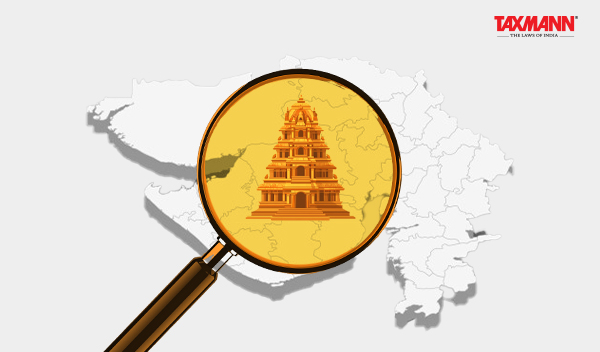Mystical Temples of Gujarat – Secrets | Stories | Unique Marvels
- Other Laws|Blog|
- 7 Min Read
- By Taxmann
- |
- Last Updated on 28 April, 2025

Gujarat, a land steeped in history and spirituality, is home to some of India's most mystical temples—each holding secrets, legends, and unique wonders. From the timeless grandeur of Somnath Temple, the first Jyotirlinga, to the disappearing act of Stambheshwar Mahadev, and the magnetic mysteries of Tulsi Shyam nestled in Gir’s wilderness—these sacred sites offer a journey beyond faith, into the realm of nature’s marvels and ancient lore.
Table of Contents
- Somnath Temple – Gujarat (Saurashtra)
- Shri Stambheshwar Mahadev Temple – Gujarat (Bharuch)
- Tulsi Shyam Temple – Gujarat (Sasan Gir)
Check out Taxmann's Mysterious Temples of India which offers a panoramic exploration of the country's sacred heritage, featuring over 90 temples known for unsolved mysteries, miraculous rituals, and architectural marvels. Spanning Himalayan shrines to Dravidian sanctuaries, it reveals how mythology, folklore, and scientific perspectives intersect—showcasing 'hanging' pillars, ever-burning lamps, and even exorcism rites. A dedicated focus on seven Shiva temples aligned along the 79° E longitude illustrates the deep interplay between faith and cosmic geometry. With historical context, travel guidance, and emphasis on preserving these ancient structures, the book is an enlightening guide for spiritual seekers, cultural explorers, and curious readers.
1. Somnath Temple – Gujarat (Saurashtra)
Somnath Temple is a significant Hindu temple and is considered the first among the 12 Jyotirlingas.
Located in the Veraval Port of the Saurashtra region in Gujarat, this temple is said to have been constructed by the Moon God (Chandra Dev) himself. It is even mentioned in the Rigveda. This place is considered one of the most mysterious and sacred. It was a major site for the Yaduvanshis. The temple has been destroyed 17 times over history and rebuilt each time.
Somnath Temple is situated at Prabhas Patan, near the Veraval Port on the western coast of Gujarat, in the Saurashtra region. It is considered the first of the 12 Jyotirlinga temples dedicated to Lord Shiva in India. The temple is a significant pilgrimage and tourist destination in Gujarat. In ancient times, this temple was repeatedly destroyed by foreign Muslim invaders and the Portuguese. After the repeated invasions, the current Hindu temple was rebuilt in the architectural style of the Chalukyas. The temple was looted by Mahmud of Ghazni, a well-known event in history. After this incident, the temple gained worldwide recognition.
According to Spiritual guru Sri Sri Ravi Shankar, some priests took away the fragments of a Shiva Linga from the famous Somnath temple in Gujarat after Mahmud of Ghazni invaded India in the 11th century and destroyed the Somnath Temple including the Shiva Lingam. In a clip shared on social media by Sri Sri Ravi Shankar’s official handle, the spiritual leader said that after Mahmud of Ghazni attacked and destroyed the Somnath Temple along with the Jyotirlingam in 1026 CE, a few Agnihotri Brahmins secretly carried the pieces of the broken Shiva Lingam with them to Tamil Nadu, moulded them into small Shivalingas and continued to secretly worship them through the generations.
The social media post of Sri Sri Ravi Shankar ji says that “A thousand years ago, when Mahmud of Ghazni invaded India, he destroyed the Somnath temple on his 18th attack. Some priests then took the broken pieces of the Shiva Linga with them. One such family sculpted those pieces into a Shiva Linga and worshipped them across several generations. In 1924, the then Shankaracharya instructed the family to keep it hidden for 100 years, and continue to worship it. Now the Shankaracharya guided the family to bring it here to Bengaluru!”
These relics eventually came into the care of the family of Agnihotri Brahmin Pandit Sitaram Shastri who took them to Sri Sri Ravi Shankar ji on the advice of Kanchi Shankaracharya HH Vijayendra Saraswati ji.
As per media reports, Sri Sri Ravi Shankar ji has been entrusted the task of reinstallation of this Shiva Linga .
Originally, the temple was also known as Prabhas Kshetra, and it is believed to be the place where Lord Krishna gave up his mortal form.
It is said that the gates of the temple, now kept in Agra, were looted by Mahmud of Ghazni and taken away.
“Somnath” means “Lord of the Moon” – referring to the fact that Chandra dev (Moon God) married the 27 daughters of Daksha Prajapati, but loved only Rohini. The other 26 wives complained to their father Daksha, who cursed Chandra Dev to lose his shine. Through the worship of Lord Shiva, Chandra Dev regained his shine.
The Somnath Temple is dedicated to Lord Shiva and is located at a place where there is no land between it and Antarctica along a straight line through the sea.
The temple’s spire rises to a height of 150 feet, and it contains a sanctum sanctorum (garbhagriha), an assembly hall (sabhamandapa), and a dance hall (natyamandapa).
In ancient times, the Shivling in the temple hung in mid-air, but it was destroyed by invaders. It is believed that 24 Shivlings were installed, with Somnath’s Shivling placed in the center. Some of these Shivlings are located under the Tropic of Cancer in the sky.
The Shivling in Somnath Temple has radioactive properties that help it maintain balance above the ground. The construction of the temple took five years.
To the south of the temple, on the shore of the sea, stands a pillar called the Banasthambha. At the top of this pillar, an arrow is placed, symbolising that there is no land between Somnath Temple and the South Pole.
Here, at the confluence of three rivers – Hiranya, Kapila and Saraswati – people come to bathe in this Triveni Sangam. The temple complex spreads over an area of 10 kilometers and contains 42 temples.
The Kalash (a sacred water vessel) at the summit of the temple weighs 10 tons, and its flag stands 27 feet tall.
2. Shri Stambheshwar Mahadev Temple – Gujarat (Bharuch)
There is a temple that submerges in water and emerges twice a day. This is the famous Stambheshwar Mahadev Temple, located near Vadodara, also known as the submerged Shiva temple. Situated a little away from the coastline, the temple becomes fully submerged during high tide, leaving only its peak visible. However, as the tide recedes, it reappears, and devotees can enter the temple to pray.
The Stambheshwar Mahadev Temple is one of the most unique temple dedicated to Lord Shiva in India. It is about 150 years old and is steeped in numerous legends. People often refer to it as the “disappearing temple” or “vanishing temple” because it hides itself from view twice a day! Why does this temple play hide-and-seek with its devotees?
To understand this, we need to know the temple’s location. The Stambheshwar Mahadev Temple is situated in Kavi Kamboi, Gujarat, around 70 km from Vadodara. It stands just a few feet away from the Arabian Sea. Twice a day, during high tide, the temple becomes completely submerged. Recently, state authorities have built a spire on top of the temple, which is the only part visible during high tide. When the low tide arrives, devotees can visit the temple, offer prayers, and return. Flowers offered during low tide are carried away by the waves during high tide, creating a colorful sight along the coastline.
The transition from low tide to high tide is spectacular. It seems as if the water itself is offering its prayers to the four-foot-long Shivling found in the temple by performing ‘abhishek’ of the shivling.
The temple, in the middle of the sea, appears thrilling even just in its visual appeal. Inside the temple, devotees can perform regular worship and rituals. However, the temple’s most fascinating ritual is performed by the sea itself, morning and evening. When the sea waves rise fiercely in the morning and evening, it appears as though the waves are performing the Abhishekam of Mahadev. The peak of the temple is visible, but the Shivling is submerged in the waves. This divine play of Lord Shiva’s “appearance” and “disappearance” has been going on for thousands of years.
At this temple, Lord Shiva disappears for 6 hours a day. This remarkable sight occurs in the morning and again in the evening when the high tide arrives. Thus, Lord Shiva meditates under water daily for 12 hours. Devotees patiently wait with folded hands until Lord Shiva reappears.
The temple is located about 85 km from the district headquarters, on the seashore of Jambusar, about 1 km inside the sea, and is accessed via a platform. The mystery of this temple lies in its sanctum, where the Shivling is visible only twice a day. Despite being submerged for centuries, the sanctum and Shivling remain unharmed. The Shivling is believed to be thousands of years old and was discovered in the same location where the Stambheshwar Temple stands today.
Once the tide rises, the sanctum gets filled with about 1 foot of sea sand, which takes about 1 to 1.5 hours and thousands of liters of clean water to clear. The process of waves cleansing the sanctum is entirely natural. However, the biggest mystery remains – how was the Shivling installed in such a difficult location, and what technique was used to build the temple that has withstood the waves for thousands of years?
3. Tulsi Shyam Temple – Gujarat (Sasan Gir)
The Tulsi Shyam Temple is dedicated to Lord Krishna and is situated in the heart of the Sasan Gir National Park, around 30 kilometers inside the jungle from Una. The temple is surrounded by hills, with the temple of Goddess Rukmini at the top. It is believed that when Lord Krishna and Rukmini had a fight, Rukmini, upset, ascended the hill, and since then, her temple has remained on the hilltop.
Tulsi Shyam Mandir is situated in Giri National Park so that during the journey, you can see natural beauty, waterfalls, river, mountain and also wild animals, lion, leopard, sambar, and peacock.
Tulsi Shyam Temple is famous not only for its religious significance but also for the unique phenomena that occur here, such as the Magnetic Hills and hot water springs.
The Magnetic Hills area is located about 500 meters from the temple, where there is a zero-gravity zone. In this zone, a car will start climbing uphill on its own! Objects in this area are naturally pulled upwards, and water flows uphill.
There are three hot water springs near the temple, with each having a different temperature. The sulphur-rich water in these springs is believed to cure skin diseases.
500 meters away from the temple is Bhimsa, a place where the five Pandavas are said to have stayed, and where Bhima is believed to have carved marks on a stone, which are still visible.
Many places from the Mahabharata era still bear testimony to the great history of that time. Some are associated with Lord Krishna, while others are witnesses to the penance and repentance of the Pandavas. After the destructive war of Mahabharata, the Pandavas continued their efforts to free themselves from the sin of killing their own relatives.
In the Himalayan region, there are many temples where the Pandavas meditated and prayed to Lord Shiva for repentance. One such place is located on the Arabian Sea coast in Gujarat, where Lord Shiva absolved the five Pandavas of their sins. This is why the Nilkanth Mahadev Temple was established here, where five self-manifested Shivlings (naturally occurring) are situated.
Disclaimer: The content/information published on the website is only for general information of the user and shall not be construed as legal advice. While the Taxmann has exercised reasonable efforts to ensure the veracity of information/content published, Taxmann shall be under no liability in any manner whatsoever for incorrect information, if any.

Taxmann Publications has a dedicated in-house Research & Editorial Team. This team consists of a team of Chartered Accountants, Company Secretaries, and Lawyers. This team works under the guidance and supervision of editor-in-chief Mr Rakesh Bhargava.
The Research and Editorial Team is responsible for developing reliable and accurate content for the readers. The team follows the six-sigma approach to achieve the benchmark of zero error in its publications and research platforms. The team ensures that the following publication guidelines are thoroughly followed while developing the content:
- The statutory material is obtained only from the authorized and reliable sources
- All the latest developments in the judicial and legislative fields are covered
- Prepare the analytical write-ups on current, controversial, and important issues to help the readers to understand the concept and its implications
- Every content published by Taxmann is complete, accurate and lucid
- All evidence-based statements are supported with proper reference to Section, Circular No., Notification No. or citations
- The golden rules of grammar, style and consistency are thoroughly followed
- Font and size that’s easy to read and remain consistent across all imprint and digital publications are applied




 CA | CS | CMA
CA | CS | CMA
